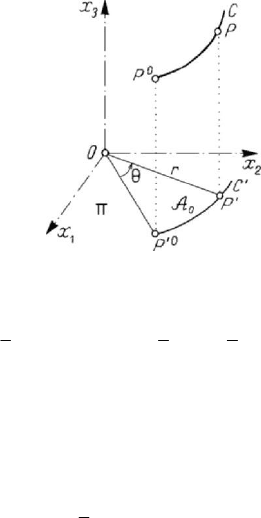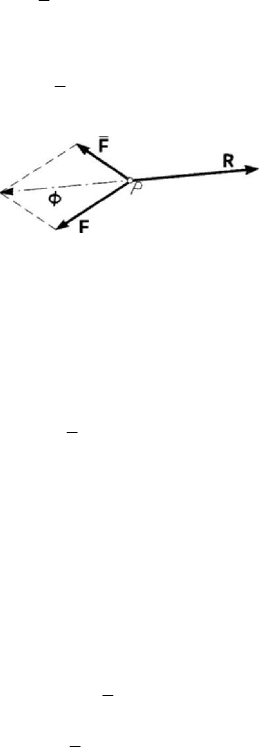Teodorescu P.P. Mechanical Systems, Classical Models Volume I: Particle Mechanics
Подождите немного. Документ загружается.


Dynamics of the particle with respect to an inertial frame of reference
381
where
consth
=
, hence to a scalar first integral. Introducing the potential energy
(6.1.14) or (6.1.14') and the mechanical energy (6.1.15), we may write
ETV h=+=, consth
=
(6.1.55'')
too, obtaining thus
Theorem 6.1.16 (mechanical energy conservation theorem). The mechanical energy of
a free particle is conserved in time if and only if the resultant of the given forces which
act upon it is conservative.
Thus, the denomination given to these forces, which form a conservative field, is
justified;
h is the energy constant.
The mechanical energy conservation theorem allows to determine the magnitude of
the velocity of the particle without knowing its trajectory; we may thus write
[]
2
2
()vhV
m
=−
r .
(6.1.56)
We notice that – in particular – the motion of a particle constrained to stay on an
equipotential surface and acted upon by the corresponding conservative force is
uniform.
The constants corresponding to the first integrals introduced above may be
determined observing that the latter ones are conserved in time (the respective functions
have the same value at any moment
t , inclusive at the initial moment
0
tt= ). Thus, in
the case of the linear momentum conservation theorem it results
0
m
=
Cv, in the case
of the angular momentum conservation theorem we have
00
()m=×Cr v, while in
the case of the mechanical energy conservation theorem we may write
2
00
/2 ( )hmv V=+r .
1.2.6 Theorem of areas. Central forces
Starting from the velocities torsor (5.1.16'), multiplying by the mass m and taking
into account (6.1.1), (6.1.2), we find again the torsor of momentum (6.1.4); multiplying
– analogously – the accelerations torsor (5.1.20') by
m and taking into account
(6.1.45), (6.1.46'), we obtain the torsor theorem (6.1.47). We can thus see that the areal
velocity and acceleration play for the angular momentum and its derivative a rôle
similar to that played by the velocity and the acceleration for the linear momentum and
its derivative, respectively. Thus, if the force
F is coplanar (concurrent or parallel)
with an axis
Δ of unit vector
u
( 0M
Δ
=
), then the projection of the areal velocity
O
Ω of the free particle P on the axis Δ is constant in time
11
(, , )
22
iij
OOiijkk
uxvuCΩ⋅= = =∈ =urvuΩ ,
constC
=
,
(6.1.57)
obtaining a scalar first integral equivalent to (6.1.54); associating a particle
P
′
to the
projection of the particle
P on a plane Π normal to the axis Δ , we may state that the

MECHANICAL SYSTEMS, CLASSICAL MODELS
382
areal velocity of the particle
P
′
with respect to the trace of the axis Δ on the plane Π
is conserved in time. Assuming that the axis
Δ coincides with the axis
3
Ox , we may
write
()()
12 21 12 2 1
3
11
22
O
xv xv xx xx CΩ
=
−= −=
, constC
=
.
(6.1.57')
As well, if the moment
O
M has a fixed support, then we obtain two independent
scalar first integrals of the form (6.1.57). If the force
F is contained in a fixed plane
Π , then the trajectory of the particle P is a plane curve, while the moment of
momentum is of the form
()
OO
Kt
=
Ku, where vers
O
=
uK is normal to the plane
Π ; one can easily see that
[
]
() () 0
OO
mKt⋅=⋅× = ⋅=rK r r v ur ,
hence
0⋅=ur , so that this is the equation of the plane
Π
, which passes through
O
.
The condition
O
=M0 is verified if and only if the support of the given force F
passes through the pole O ; such a force is called central force. In such a case, the
moment of momentum conservation theorem takes place; we also obtain
11
22
O
=×=rv CΩ , const=
C ,
11
22
j
i
Oi ijk k
xv CΩ =∈ = , 1, 2, 3i
=
, (6.1.57'')
hence, a vector first integral, equivalent to three scalar first integrals, and we may state
Theorem 6.1.17 (areal velocity conservation theorem). The areal velocity of a free
particle with respect to a fixed pole is conserved in time if and only if the resultant of
the given forces which act upon it is a central force (its support passes – permanently –
through the same pole).
In the latter case
(
)
(
)
1/2 ( , , ) 1/2
O
⋅= = ⋅rrvrCrΩ ; hence, the trajectory of the
particle
P is a plane curve, contained in the plane
0⋅=Cr , const
=
≠
C0,
(6.1.58)
which passes through the pole
O . If
=
C0, then it results that r and v are collinear
vectors; the equation
()tλ=
rr, λ scalar, leads to
0
()d
0
t
t
e
λτ τ
∫
=
rr ,
(6.1.58')
the trajectory of the particle being rectilinear. We notice that
00
=×Cr v. As a
conclusion, if the moment
O
M has a fixed support, then the trajectory of the particle
P is rectilinear or a plane curve (contained in the plane Π ) as the vectors
0
r and
0
v
of the initial conditions have or not the same support.

Dynamics of the particle with respect to an inertial frame of reference
383
Assuming that the plane
Π coincides with the plane
12
Ox x , the particle P
describes the curve
C , the trajectory of the particle P
′
being the curve C
′
, the
projection of the curve
C on the plane Π (Fig.6.5); if the trajectory C is a plane
curve, in the conditions mentioned above, then
PP
′
≡
. We may write
Figure 6.5. Areas theorem.
()
2
12 21
3
111
222
O
xx xx r CΩθ=−==
,
(6.1.59)
where we used polar co-ordinates in the plane Π ; the first integral
2
rCθ =
is called
also the areas first integral. Noting that
3
d/d
OO
tΩ
=
A
, where we have attached the
sign +, to the area
O
A
, corresponding to a positive rotation in the plane Π , we get
()
0
1
2
O
Ct t=−A ,
(6.1.59')
and are led to
Theorem 6.1.18 (areas theorem). The area described by the vector radius of a free
particle, beginning with its initial position, is proportional to the interval of time
covered if and only if the resultant of the given forces which act upon it is a central
force.
We can also say that the vector radius describes equal areas in equal times. The
constant
C is called the areas constant. We mention that this theorem has been stated
in the same conditions in which the areal velocity conservation theorem takes place; but
it can be applied to the particle
P
′
too (Fig.6.5), in the case in which we may write
only a single scalar first integral of the form (6.1.57).
Taking into account the observations made at the beginning of this subsection, the
angular momentum theorem allows to write
2
OO
m =
MΩ
(6.1.60)
and we may state
MECHANICAL SYSTEMS, CLASSICAL MODELS
384
Theorem 6.1.19 (areal acceleration theorem). The product of the double mass of a free
particle by its areal acceleration with respect to a fixed pole is equal to the moment of
the resultant of the given forces which act upon it, with respect to the same pole.
Hence, the equation (6.1.60) plays – with respect to the moment
O
M
– the same rôle
as that played by Newton’s equation (1.1.89) with respect to the force
F
.
2. Dynamics of the particle subjected to constraints
Assuming that the particle is subjected to ideal constraints or to constraints with
friction, we complete – in what follows – the general and conservation theorems
previously stated and emphasize the differential principles of mechanics for a particle.
Using then the general results thus obtained, we study the motion of a particle
constrained to stay on a curve or on a surface; the case of constraints with friction is
also taken into consideration. By means of the generalized co-ordinates, we may study
the motion of a particle with only one degree of freedom in the conservative case, as
well as in a dissipative case.
2.1 General considerations
The case of one or two ideal holonomic (rheonomic or scleronomic) constraints is
considered and the equation of motion, the general and the conservation theorems are
completed by introducing the constraint forces. We mention also the presentation of
other differential principles of mechanics (d’Alembert, d’Alembert-Lagrange),
equivalent to Newton’s differential principle.
2.1.1 Ideal constraints. Introductory notions
We introduced in Chap. 3, Sec. 2.2 the notion of constraint, together with its multiple
implications. Using the considerations made on this occasion, we assume that a particle
may be subjected to two holonomic (finite, of geometric nature) bilateral constraints of
the form (3.2.17); if a third constraint, compatible with the first two ones, would appear,
then the position of the particle would be specified from geometric point of view
(uniqueness or not). The case of non-holonomic constraints of the form (4.1.37') will be
studied subsequently by analytical methods. As well, we admit the existence of
unilateral constraints of the form (3.2.8') in some particular problems.
If the particle is constrained to stay on a curve
C , then its co-ordinates must verify
the relations
(
)
1123
,,; 0
f
xxxt
=
,
(
)
2123
,,; 0
f
xxxt
=
(6.2.1)
or the relations
(
)
1123
,, 0
f
xxx
=
,
(
)
2123
,, 0
f
xxx
=
,
(6.2.1')
as the constraint is rheonomic or scleronomic, respectively; in the first case, the curve is
movable, while in the second one it is fixed. The particle remains with only one degree
Dynamics of the particle with respect to an inertial frame of reference
385
of freedom and its position may be specified by means of a single independent
parameter
q (obtained by eliminating the two considered constraints) in the form
(;)qt=rr , (;)
ii
xxqt
=
, 1, 2, 3i
=
, ()qqt
=
,
(6.2.2)
in the general case of a rheonomic constraint. In particular, the generalized co-ordinate
q
may be the curvilinear co-ordinate s on the curve
C
or even the time
t
.
Analogously, to determine the positions of a particle constrained to stay on a surface
S of equation
(
)
123
,,; 0
f
xxxt
=
(6.2.3)
or
(
)
123
,, 0
f
xxx
=
,
(6.2.3')
as the constraint is non-stationary (movable surface) or stationary (fixed surface),
respectively, there are necessary two parameters
12
,qq (obtained by the elimination of
the considered constraint), corresponding to two degrees of freedom; it results
12
(, ;)qqt=rr ,
12
(, ;)
ii
xxqqt= , 1, 2, 3i
=
, ()qqt
αα
=
, 1, 2α = .
(6.2.4)
The generalized co-ordinates
12
,qq, may – eventually – be the co-ordinates on the
surface
S .
Using the axiom of liberation from constraints, we introduce the constraint force
R
so that, corresponding to the formula (3.2.35'), the equation of motion (6.2.2) becomes
mm==+
arFR,
iiii
ma mx F R
=
=+ , 1, 2, 3i
=
; (6.2.5)
in such conditions, the particle behaves as a free one. If the constraints are ideal, then
one obtains the virtual work
0
R
W
δ
=⋅δ=Rr
; in the cases considered above, the
constraint force
R
is normal to the surface
S
, hence it is of the form
grad
f
λ=R
,
,ii
Rfλ
=
,
1, 2, 3i
=
, λ scalar, (6.2.6)
or it belongs to the normal plane to the curve
C , hence it is of the form
1122
grad grad
f
fλλ=+R
,
11, 22,
i
ii
Rf fλλ
=
+ , 1, 2, 3i
=
,
12
,λλ
scalars, (6.2.6')
at the point occupied by the particle (corresponding to the formula (3.2.37)). A
constraint with friction implies a constraint force tangent to the surface
S or to the
curve
C , which is determined by a supplementary modelling of the mechanical
phenomenon.
We observe that all the results obtained in the case of a free particle may be used also
for a particle subjected to constraints if to the resultant
F of the given forces is

MECHANICAL SYSTEMS, CLASSICAL MODELS
386
added also the resultant
R (unknown) of the constraint forces. In the first basic
problem, besides the trajectory (the vector function
()t
=
rr) is asked also the
constraint force
R (which involves – in general – three unknown scalar components).
In the second basic problem, one must determine the forces
F and R ; as in the case
=R0, the problem has not a unique solution. As well, neither in the case of the mixed
basic problem the solution is not unique.
In what concerns the theorem of existence and uniqueness, they remain further valid
if the functions (6.2.1') and (6.2.3') are of class
1
C and their derivatives of first order
fulfil conditions of Lipschitz type.
2.1.2 General theorems
Corresponding to the results in Subsec. 1.2.4, we may write
=+
HFR,
iii
HFR
=
+
, 1, 2, 3i
=
,
(6.2.7)
()
OOO
=× + = +
KrFRMM,
Oi Oi Oi
KMM=+
, 1, 2, 3i
=
,
(6.2.7')
thus stating:
Theorem 6.2.1 (theorem of momentum). The derivative with respect to time of the
momentum of a particle subjected to constraints is equal to the resultant of the given
and constraint forces which act upon it.
Theorem 6.2.2 (theorem of moment of momentum). The derivative with respect to time
of the moment of momentum of a particle subjected to constraints, with respect to a
fixed pole, is equal to the moment of the resultant of the given and constraint forces
which act upon it, with respect to the same pole.
Introducing the notion of hodograph, we may state theorems analogous to Theorems
6.1.7' and 6.1.8'.
Noting that
() () ()
OOO
τ=τ+τ
HFR,
(6.2.7'')
we may state
Theorem 6.2.3 (theorem of torsor). The derivative with respect to time of the torsor of
momentum of a particle subjected to constraints, with respect to a fixed pole, is equal to
the torsor of the resultant of the given and constraint forces which act upon it, with
respect to the same pole.
Introducing the impulse of the constraint force
2
1
d
t
t
t
∫
R and the impulse of the
moment of the constraint force
2
1
d
t
O
t
t
∫
M , corresponding to the interval of time
[
]
12
,tt , we may write
22
11
dd
tt
tt
ttΔ= +
∫∫
HF R,
(6.2.8)
22
11
dd
tt
OO O
tt
ttΔ= +
∫∫
KM M,
(6.2.8')

Dynamics of the particle with respect to an inertial frame of reference
387
(
)
(
)
22
11
() d d
tt
OO O
tt
ttΔτ = τ + τ
∫∫
HF R
.
(6.2.8'')
The relation (6.1.48) is completed in the form
dd d d d
R
TWW=+ =⋅+⋅FrRr
(6.2.9)
and we may state
Theorem 6.2.4 (theorem of kinetic energy). The differential of the kinetic energy of a
particle subjected to constraints is equal to the sum of the elementary works of the
resultants of the given and constraint forces which act upon it.
As it was seen in Chap. 3, Subsec. 2.2.9, in the case of scleronomic (or – more
general – catastatic) constraints, we have
d0
R
W
=
; in this case, the Theorem 6.2.4,
corresponding to a particle subjected to constraints, is of the same form as the Theorem
6.1.10, corresponding to a free particle. In what concerns Theorems 6.1.10' and 6.1.10'',
one can make analogous observations.
We notice that, if we take the moment of momentum with respect to a pole
Q ,
movable with respect to the origin
O , the formula (6.1.52) leads to
QQQQ
=
+−×
KMMvH
.
(6.2.10)
2.1.3 Conservation theorems
Using the results given in Subsec. 1.2.5, we may build up first integrals, in certain
conditions, in the case of a particle subjected to constraints too. Thus, if the sum
+FR
is parallel to a fixed plane (is normal to a fixed direction of unit vector u ,
()0+⋅=FRu ), then we may write the first integral (6.1.53); analogously, if the sum
OO
+MM is contained in a fixed plane (is normal to a fixed axis Δ , O Δ∈ , of unit
vector
u ,
(
)
0
OO
+⋅=MMu ), then one obtains the first integral (6.1.54).
If
+=FR 0 (necessary and sufficient condition of static equilibrium), then we
may state a momentum conservation theorem, while if
OO
+
=MM 0 (necessary
condition of static equilibrium), then we may state a moment of momentum
conservation theorem. The first condition mentioned above allows to state a torsor
conservation theorem too.
In the case of scleronomic constraints and of a conservative force we may write also
a mechanical energy conservation theorem.
The moment of momentum conservation theorem is equivalent to the areal velocity
conservation theorem; these theorems take place if and only if the sum
+FR passes
through the fixed pole
O (it is a central force).
As in the case of a free particle, one can obtain only six independent first integrals;
but these ones are sufficient to determine the motion. Even if the constraint force
R is
not known a priori, the conditions imposed above are often fulfilled, and we may set up
first integrals in the case of the particle subjected to constraints too.

MECHANICAL SYSTEMS, CLASSICAL MODELS
388
2.1.4 Differential principles of mechanics
The equation of motion of a particle P subjected to constraints is written in the form
(6.2.5); this equation represents Newton’s principle (the first differential principle of
mechanics). But this basic principle can be expressed also in other equivalent forms,
which are useful in various particular cases; if we consider these forms as consequences
of Newton’s principle, then they will be theorems.
Introducing the force of inertia
m
=
−
Fr,
(6.2.11)
the law of motion becomes
+
+=FFR 0
(6.2.12)
Figure 6.6. D’Alembert’s theorems.
and we may state (Fig.6.6)
Theorem 6.2.5 (d’Alembert). The motion of a particle subjected to constraints takes
place so that – at any moment – it is in dynamic equilibrium under the action of the
resultant of the given and constraint forces, as well as of the force of inertia.
We introduce the force
m
=
+=−
FF F rΦ ,
(6.2.13)
which is called the lost force of d’Alembert; in this case, the equation becomes (Fig.6.6)
+
=R0
Φ
(6.2.14)
and we can state
Theorem 6.2.6 (d’Alembert). The motion of a particle subjected to constraints takes
place so that the constraint force be equilibrated – at any moment – by the lost force of
d’Alembert.
We notice that the relation (6.2.13) may be written also in the form
() m=+−=+
FF rΦΦ;
hence, only the component
m
=
−
rF of the force
F
contributes to the motion of the
particle, while the component
Φ
is lost because it equilibrates the constraint force
(justifying thus the given denomination).
Formally, the equation (6.2.14), which represents the necessary and sufficient
condition for dynamic equilibrium (characterizing – entirely – the motion of the particle
subjected to constraints), is not different from the relation (4.1.4), which represents the
Dynamics of the particle with respect to an inertial frame of reference
389
necessary and sufficient condition of static equilibrium. As a consequence, all the
considerations made for static problems, starting form the relation (4.1.4), may be
transposed for similar problems of dynamic character, replacing the given force
F by
the lost force of d’Alembert
Φ
; e.g., the condition (4.1.56), written for only one
particle, leads to the theorem of torsor, characterized by the formula (6.2.7''). As well,
we may use the results in Chap. 4, Subsecs. 1.1.5, 1.1.6, 1.1.8, corresponding to the
particle constrained to stay on a surface or on a curve.
If
0
R
Wδ=, then we may write the relation (4.1.58) for a single particle in the form
0W
δ
=⋅δ=r
Φ
, (6.2.15)
stating
Theorem 6.2.7 (theorem of virtual work; d’Alembert-Lagrange). The motion of a
particle subjected to ideal constraints takes place so that the virtual work of the lost
force of d’Alembert, which acts upon the particle, vanishes for any virtual displacement
of it.
In the case of unilateral ideal constraints of the form (3.2.16
iv
) or of the form
(3.2.16), the virtual work of the lost force of d’Alembert verifies the relation
0W
δ
=⋅δ≤r
Φ
. (6.2.15')
We notice that each of the above theorems may stay at the basis of the Newtonian
mathematical model of mechanics, representing thus a differential principle of
mechanics.
2.2 Motion of the particle with one or two degrees of freedom
In what follows, we consider the motion of a particle (frictionless or with friction),
constrained to stay on a curve or on a surface. A study is then made for the case in
which the particle has only one degree of freedom (conservative or dissipative case).
2.2.1 Motion of a particle constrained to stay on a curve
Let P be a particle in motion on a smooth movable or fixed curve C (Fig.6.7) of
equations (6.2.1) or (6.2.1'). The constraint force will be expressed in the form (6.2.6'),
while the equation of motion will be
1122
grad gradmffλλ=+ +
rF ; (6.2.16)
in components, we may write
11, 22,
ii
ii
mx F f fλλ=+ + ,
1, 2, 3i
=
. (6.2.16')
The equations (6.2.1) and (6.2.16') form a system of five scalar equations for the
unknown functions
()
ii
xxt= and for the parameters
1
λ and
2
λ , which specify the
constraint force.
We notice that, in the case of the rheonomic constraints,

MECHANICAL SYSTEMS, CLASSICAL MODELS
390
grad d d 0
f
ft
αα
⋅
+=
r , 1, 2α
=
,
Figure 6.7. Motion of a particle constrained to stay on a curve C.
the real work of the constraint forces is written in the form
(
)
11 22 1122
ddgraddgradd d
R
Wfffftλλ λλ=⋅ = ⋅ + ⋅ =− +
Rr r r ,
being non-zero; indeed, taking into account the variation in time of the curve, the real
displacement of the particle is not tangent to the curve frozen at the moment
t , in the
normal plane of which is the constraint force
R .
If the constraint is scleronomic or, at least, catastatic, then the work
d0
R
W = ; in
this case, the curve
C is fixed and the trajectory coincides with it, the constraint force
belonging to the normal plane to the trajectory at the point
P . In the theorem of kinetic
energy (6.2.9), the constraint force does no more appear, and we may specify the
position of the particle on the trajectory. The parametric representation (6.2.2) becomes
()
ii
xxq= , 1, 2, 3i = , so that we obtain
(
)
2
d
(,;)
d2
ii
m
xxq Qqqt q
t
′′
=
,
(6.2.17)
where
d()/d
ii
xxqq
′
=
, while (,;) (,;) (,;) ()
ii
Qqqtq t F qqtx q
=
⋅=
Frr r , which
determines the generalized co-ordinate
()qqt
=
. In particular, if the given force
depends only on the position of the particle (
()
=
FFr), then we have ()QQt= , so
that
()
0
22
0
()d
2
q
q
m
vv Qηη−=
∫
.
Noting
0
2
0
12
() ()d
q
q
ii
qvQ
xx m
ϕηη
⎡
⎤
=+
⎢
⎥
′′
⎣
⎦
∫
,
(6.2.18)
the equation (6.2.17) becomes
